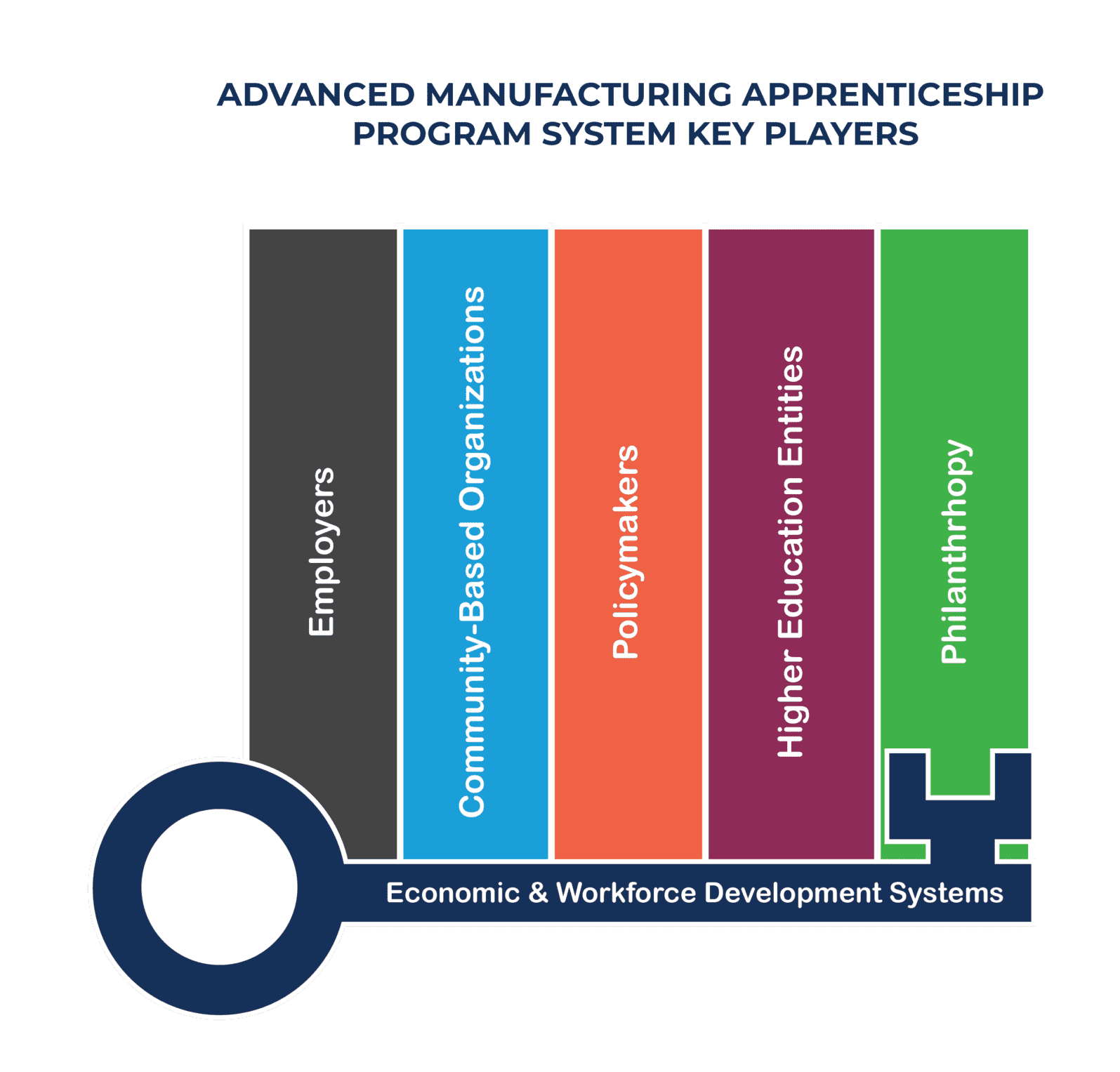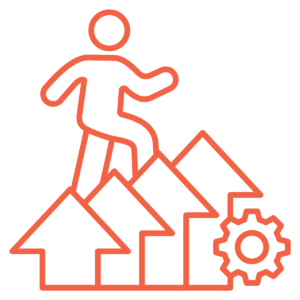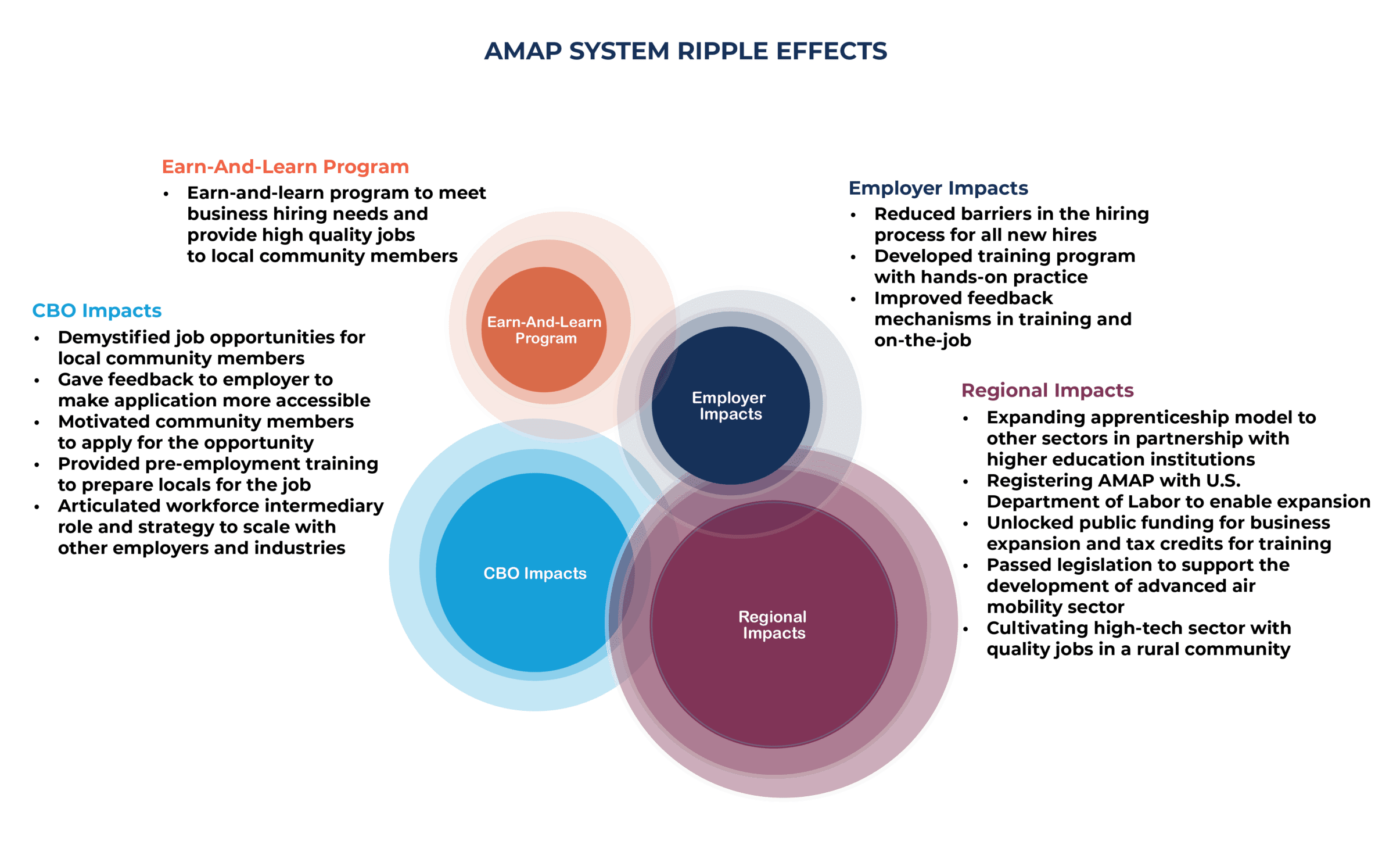Securing a Successful Future for Workers, Communities, and Businesses: Advanced Manufacturing Apprenticeship Program Case Study
 For decades, the development of highly technical industries has been concentrated in a few large metropolitan areas, limiting potential economic benefits at the regional level and access to opportunity at the individual worker level. Businesses in these industries are looking for an available, abundant, and skilled talent pool, but have historically cultivated limiting mental models of what that talent pool looked like in terms of demographics, education background, and experience. Recent federal funding initiatives that support the tech industry’s regional expansion have demonstrated that this regional imbalance can be reset with the right intentionality, support systems, cross sector collaboration, and incentives. Additionally, in the workforce development field, the rise of skills-based hiring offers a more equitable approach to securing that coveted talent pool. When these things are in place, it frees up employers to choose operating locations based on other strategic priorities if they know there are viable ways of building the workforce they need.
For decades, the development of highly technical industries has been concentrated in a few large metropolitan areas, limiting potential economic benefits at the regional level and access to opportunity at the individual worker level. Businesses in these industries are looking for an available, abundant, and skilled talent pool, but have historically cultivated limiting mental models of what that talent pool looked like in terms of demographics, education background, and experience. Recent federal funding initiatives that support the tech industry’s regional expansion have demonstrated that this regional imbalance can be reset with the right intentionality, support systems, cross sector collaboration, and incentives. Additionally, in the workforce development field, the rise of skills-based hiring offers a more equitable approach to securing that coveted talent pool. When these things are in place, it frees up employers to choose operating locations based on other strategic priorities if they know there are viable ways of building the workforce they need.
In Securing a Successful Future for Workers, Communities, and Businesses: Advanced Manufacturing Apprenticeship Program Case Study, we explore Joby Aviation’s Advanced Manufacturing Apprenticeship Program (AMAP), an innovative model developed in partnership with Monterey Bay Drone, Automation, and Robotics Technology (DART) and the James Irvine Foundation that supports inclusive economic development through partnership between private business, local community members, and regional economic stakeholders.

This emergent apprenticeship pilot is already demonstrating a range of benefits within two years of its inception: a paid training pathway providing high-quality jobs for local community members in a growing tech industry, and state-level policy support, with the potential to diversify the economy in California’s Monterey Bay region.
The Challenge
Joby Aviation, an aerospace company developing electric air taxis for commercial passenger service, was operating in Marina, CA and entering a new phase of business in building out its manufacturing workforce as they shifted from R&D to the pilot production phase of their electric vertical take-off and landing (eVTOL) aircraft.
 The business needed manufacturing employees and wanted the pilot production facility to be near their R&D facilities
The business needed manufacturing employees and wanted the pilot production facility to be near their R&D facilities- Local economic development players were motivated to retain Joby and create jobs locally while also supporting the growing Advanced Air Mobility (AAM) industry in the Monterey Bay region
- Surveys with employers, community-based organizations, and local government indicated a skill and training gap in the area – the region lacked a mature advanced manufacturing workforce training pipeline
- At the same time, local CBOs were repositioning themselves as valued actors in inclusive economic development, building on their efforts to help Joby understand the skills and aptitudes of the local workforce and to connect community members with paid earn-and-learn career pathways that provide upward mobility
- This was a time-sensitive opportunity as the pilot occurred during Joby’s national site selection process, which included consideration of other regions with a better-matched labor market
Key Players
AMAP’s early success is a result of cross-sector collaboration in which each stakeholder is bringing their complementary strengths and aligned goals together to increase the number of good quality jobs in the region and improve access to those jobs through paid earn-and-learn career pathways. Though these roles may be played by different types of organizations in your region, articulating the kinds of contributions each made in AMAP can help you envision your local equivalent. In the Monterey Bay region, this includes an employer, an economic development organization, community-based organizations, workforce development agencies, higher education, and philanthropy.

A Model That Works for Workers, Communities, and Businesses
 For businesses, this model builds a local talent pipeline where one may not currently exist, particularly in rural areas where relocating talent may prove difficult.
For businesses, this model builds a local talent pipeline where one may not currently exist, particularly in rural areas where relocating talent may prove difficult.
 Hiring local talent often means lower hiring costs, quicker onboarding, greater retention and loyalty, and a more resilient talent pipeline less vulnerable to labor supply shortages. It also may facilitate getting to market faster, which is particularly important for those developing emerging technologies.
Hiring local talent often means lower hiring costs, quicker onboarding, greater retention and loyalty, and a more resilient talent pipeline less vulnerable to labor supply shortages. It also may facilitate getting to market faster, which is particularly important for those developing emerging technologies.
 For local workers, AMAP provides an earn-and-learn model for upskilling or reskilling local community members into high-quality jobs with pathways to advancement. This can be transformative for an area like the Monterey Bay region, where communities of color constitute the majority of those in low-paying, low-mobility jobs like manual crop harvesting, retail, and housekeeping in hospitality.
For local workers, AMAP provides an earn-and-learn model for upskilling or reskilling local community members into high-quality jobs with pathways to advancement. This can be transformative for an area like the Monterey Bay region, where communities of color constitute the majority of those in low-paying, low-mobility jobs like manual crop harvesting, retail, and housekeeping in hospitality.
 For the regional economy, securing the commitment and retention of high-tech industries such as advanced air mobility distributes economic growth more equitably outside of metropolitan areas, creates more opportunities for upward mobility, and provides a more diverse and resilient economic base. Research shows that for every job in the high-tech sector created, approximately 4.3 secondary jobs are added in local goods and services sectors, creating a multiplier effect.
For the regional economy, securing the commitment and retention of high-tech industries such as advanced air mobility distributes economic growth more equitably outside of metropolitan areas, creates more opportunities for upward mobility, and provides a more diverse and resilient economic base. Research shows that for every job in the high-tech sector created, approximately 4.3 secondary jobs are added in local goods and services sectors, creating a multiplier effect.
Impacts and Ripple Effects
At its core, AMAP is designed to create two direct and complementary impacts: first, it allows Joby to find and train the local talent it needs to continue expanding its business in the Monterey Bay region; and second, local residents can access a paid earn-and-learn pathway that reduces barriers to accessing good quality jobs, ultimately increasing upward mobility. What is particularly notable about this collaborative effort is the way this pilot in a new emerging sector catalyzed changes in Joby, throughout the community, and all the way up to the regional ecosystem and policy sphere.

 The research included in this report was made possible through funding from the James Irvine Foundation. We thank them for their support but acknowledge that the findings, conclusions, and recommendations presented in this report are those of Talent Rewire and FSG alone, and do not necessarily reflect the opinions of the James Irvine Foundation.
The research included in this report was made possible through funding from the James Irvine Foundation. We thank them for their support but acknowledge that the findings, conclusions, and recommendations presented in this report are those of Talent Rewire and FSG alone, and do not necessarily reflect the opinions of the James Irvine Foundation.


 The business needed manufacturing employees and wanted the pilot production facility to be near their R&D facilities
The business needed manufacturing employees and wanted the pilot production facility to be near their R&D facilities